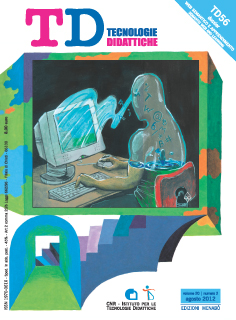Blog, video blog e audio blog nella didattica delle lingue
Contenuto principale dell'articolo
Abstract
Dettagli dell'articolo
Gli autori che pubblicano su questa rivista accettano le seguenti condizioni:
- Gli autori mantengono i diritti sulla loro opera e cedono alla rivista il diritto di prima pubblicazione dell'opera, contemporaneamente licenziata sotto una Licenza Creative Commons CC BY 4.0 Attribution 4.0 International License.
- Gli autori possono aderire ad altri accordi di licenza non esclusiva per la distribuzione della versione dell'opera pubblicata (es. depositarla in un archivio istituzionale o pubblicarla in una monografia), a patto di indicare che la prima pubblicazione è avvenuta su questa rivista.
- Gli autori possono diffondere la loro opera online (es. in repository istituzionali o nel loro sito web) prima e durante il processo di submission, poiché può portare a scambi produttivi e aumentare le citazioni dell'opera pubblicata (Vedi The effect of Open Access).
Riferimenti bibliografici
Alm A. (2006). Call for Autonomy, Competence and Relatedness. Motivating Language Learning Environments in Web 2.0. The JALT CALL Journal. (2) 3, pp. 29-38.
Banzato M. (2006). Blog e didattica. Dal web publishing alle comunità di blog. TD-Tecnologie Didattiche. 38, pp.23-31. Campbell A. (2003). Weblogs for Use with ESL Classes. Internet TESL Journal. (9) 2. http://iteslj-org/techniques/Campbell-weblogs.html (ultima consultazione 04/08/2011).
Downes S. (2009). Blogs in Learning. In S. Mishra (ed.). ELearning, STRIDE Handbook 8. New Delhi: Ians Publishing.
Ellison N., Wu Y. (2008). Blogging in the Classroom: A Preliminary Exploration of Student Attitudes and Impact on Comprehension. Journal of Educational Multimedia and Hypermedia. 17 (1), pp. 99-122. Chesapeake,VA: AACE.
Ebner M., Maurer H. (2008). Can Microblogs and weblogs change traditional scientific writing?. Proceedings of World Conference on E-learning, Las Vegas, pp. 768-776. http://lamp.tu-graz.ac.at/~i203/ebner/publication/ 08_elearn01.pdf (ultima consultazione 04/08/2011).
Ebner M., Lienhardt C., Rohs M., Meyer I. (2009). Microblogs in Higher Education: a process to facilitate informal and process-oriented learning. Computers & Education. 55 (1), pp.92-100.
Fellner T., Apple M. (2006). Developing writing fluency and lexical complexity with blogs. The JALT CALL Journal. 2 (1), pp. 15-26.
Godwin-Jones R. (2006). Tag clouds in the blogosphere: electronic literacy and social networking. Language Learning and Technology. 10 (2), pp. 8-15.
Hsu H., Wang S.K., Cornac L. (2008). Using Audioblogs to Assist English Language Learning: One Investigation into Students’ Perception. Computer Assisted Language Learning. 21 (2), pp. 181-198.
Huffaker O. (2005). The educated blogger: Using weblogs to promote literacy in the classroom. AACE Journal. 13 (2), pp. 91-98.
Jacobs J. (2003). Communication over exposure: the rise of blogs as a product of cybervoyeurism. In C. Hatcher, J. Jacobs, T. Flew (eds.). Australian and New Zealand Communication Association Conference Proceedings, Brisbane, ANZCA03 (Brisbane, Queensland, Australia, 9-11 luglio 2003). Brisbane: Queensland University of Technology.
Kern R., Ware P., Warschauer M. (2008). Network-based language teaching. http://gserv02.gse.uci.edu/person/warschauer_m/docs/ network-based.pdf (ultima consultazione 04/08/2011).
Krashen S. (1982). Principles and practice in second language acquisition. Oxford: Pergamon.
Nunan D. (2004). Task-based Language Teaching. Cambridge: Cambridge University Press.
O’Reilly T. (2005). What is Web 2.0. Design patterns and business models for the next generation software. http://oreilly.com/web2/archive/what-is-web-20.html (ultima consultazione 04/08/2011).
Pinkman K. (2005). Using blogs in the foreign language classroom: encouraging learner independence. The JALT CALL Journal. 1 (1), pp. 12-24.
Por G., Molloy J. (2002). Nurturing systemic wisdom through knowledge ecology. http://co-i-l.com/coil/knowledge-garden/kd/KE.pdf (ultima consultazione 04/08/2011).
Prensky M. (2010). Why YouTube Matters. On the Horizon. Emerald. 18 (2), pp. 124-131.
Richardson W. (2010). Blogs, wikis, podcasts and other powerful web tools for classrooms. Corwin, USA: Sage Ltd.
Solomon G., Schrum L. (2007). Web 2.0. New tools, new schools. Washington DC: ISTE
Tan Y.H., Ow J.E.G, Tan S.C (2006). Audioblogging: supporting the learning of oral communication skills in chinese language. AECT Research Symposium. Indiana: Bloomington.
Vyas M.A., Patel Y.L. (2009). Teaching English as a Second Language. A new pedagogy for a new century. New Delhi: PHI Learning Private Limited, pp. 89-99.
Vygotsky L. S. (1978). Mind and society: the development of higher psychological processes. Cambridge, MA: Harvard University Press.
Ward J.M. (2004). Blog Assisted Language Learning (BALL): push button publishing for the pupils. TEFL Web Journal. 3 (1), pp. 1-16.
Williams J.B, Jacobs J. (2004). Exploring the use of blogs as learning spaces in the higher education sector. Australasian Journal of Educational Technology. 20 (2), pp. 232-247.
Zorko V. (2007). A rationale for introducing a wiki and a blog in a blended-learning context. CALL-EJ Online. 8 (2). http://callej.org/journal/8-2/zorko.html (ultima consultazione 06/03/2012).
LINK UTILI http://edublogs.org http://teacherlingo.com/ http://webheadsinaction.org/ http://weblogg-ed.com/ https://www.blogger.com/start?hl=it http://it.wordpress.com/ www.youtube.com - http://www.teachertube.com/ http://vimeo.com/ http://www.archive.org/ http://www.blinkx.com/ http://www.eslvideo.com/index.php http://blip.tv http://www.podomatic.com/featured http://www.podcastalley.com/ http://www.learnoutloud.com/ http://www.audioblog.com/ http://www.fotobabble.com/ http://voicethread.com/

